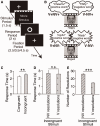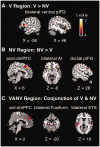Network structure underlying resolution of conflicting non-verbal and verbal social information
- PMID: 23552078
- PMCID: PMC4040092
- DOI: 10.1093/scan/nst046
Network structure underlying resolution of conflicting non-verbal and verbal social information
Abstract
Social judgments often require resolution of incongruity in communication contents. Although previous studies revealed that such conflict resolution recruits brain regions including the medial prefrontal cortex (mPFC) and posterior inferior frontal gyrus (pIFG), functional relationships and networks among these regions remain unclear. In this functional magnetic resonance imaging study, we investigated the functional dissociation and networks by measuring human brain activity during resolving incongruity between verbal and non-verbal emotional contents. First, we found that the conflict resolutions biased by the non-verbal contents activated the posterior dorsal mPFC (post-dmPFC), bilateral anterior insula (AI) and right dorsal pIFG, whereas the resolutions biased by the verbal contents activated the bilateral ventral pIFG. In contrast, the anterior dmPFC (ant-dmPFC), bilateral superior temporal sulcus and fusiform gyrus were commonly involved in both of the resolutions. Second, we found that the post-dmPFC and right ventral pIFG were hub regions in networks underlying the non-verbal- and verbal-content-biased resolutions, respectively. Finally, we revealed that these resolution-type-specific networks were bridged by the ant-dmPFC, which was recruited for the conflict resolutions earlier than the two hub regions. These findings suggest that, in social conflict resolutions, the ant-dmPFC selectively recruits one of the resolution-type-specific networks through its interaction with resolution-type-specific hub regions.
Keywords: PPI; brain; conflict monitoring; empathy; human; theory of mind.
© The Author (2013). Published by Oxford University Press. For Permissions, please email: journals.permissions@oup.com.
Figures




Similar articles
-
Contributions of self-report and performance-based individual differences measures of social cognitive ability to large-scale neural network functioning.Brain Imaging Behav. 2017 Jun;11(3):685-697. doi: 10.1007/s11682-016-9545-2. Brain Imaging Behav. 2017. PMID: 27007121
-
Diminished medial prefrontal activity behind autistic social judgments of incongruent information.PLoS One. 2012;7(6):e39561. doi: 10.1371/journal.pone.0039561. Epub 2012 Jun 22. PLoS One. 2012. PMID: 22745788 Free PMC article.
-
The modular neuroarchitecture of social judgments on faces.Cereb Cortex. 2012 Apr;22(4):951-61. doi: 10.1093/cercor/bhr166. Epub 2011 Jul 1. Cereb Cortex. 2012. PMID: 21725038 Free PMC article.
-
On emotional conflict: interference resolution of happy and angry prosody reveals valence-specific effects.Cereb Cortex. 2010 Feb;20(2):383-92. doi: 10.1093/cercor/bhp106. Epub 2009 Jun 8. Cereb Cortex. 2010. PMID: 19505993
-
Are there specialized circuits for social cognition and are they unique to humans?Curr Opin Neurobiol. 2013 Jun;23(3):436-42. doi: 10.1016/j.conb.2012.11.013. Epub 2013 Jan 2. Curr Opin Neurobiol. 2013. PMID: 23290767 Review.
Cited by
-
The attribution of animacy and agency in frontotemporal dementia versus Alzheimer's disease.Cortex. 2017 Jul;92:81-94. doi: 10.1016/j.cortex.2017.03.019. Epub 2017 Apr 8. Cortex. 2017. PMID: 28458182 Free PMC article.
-
Similarity hypothesis: understanding of others with autism spectrum disorders by individuals with autism spectrum disorders.Front Hum Neurosci. 2015 Mar 17;9:124. doi: 10.3389/fnhum.2015.00124. eCollection 2015. Front Hum Neurosci. 2015. PMID: 25852514 Free PMC article.
-
Oxytocin's neurochemical effects in the medial prefrontal cortex underlie recovery of task-specific brain activity in autism: a randomized controlled trial.Mol Psychiatry. 2015 Apr;20(4):447-53. doi: 10.1038/mp.2014.74. Epub 2014 Jul 29. Mol Psychiatry. 2015. PMID: 25070538 Free PMC article. Clinical Trial.
-
A Neuroanatomical Substrate Linking Perceptual Stability to Cognitive Rigidity in Autism.J Neurosci. 2019 Aug 14;39(33):6540-6554. doi: 10.1523/JNEUROSCI.2831-18.2019. Epub 2019 Jun 18. J Neurosci. 2019. PMID: 31213484 Free PMC article.
-
A domain-general brain network underlying emotional and cognitive interference processing: evidence from coordinate-based and functional connectivity meta-analyses.Brain Struct Funct. 2018 Nov;223(8):3813-3840. doi: 10.1007/s00429-018-1727-9. Epub 2018 Aug 6. Brain Struct Funct. 2018. PMID: 30083997 Free PMC article.
References
-
- Amodio DM, Frith CD. Meeting of minds: the medial frontal cortex and social cognition. Nature Review Neuroscience. 2006;7:268–77. - PubMed
-
- Aziz-Zadeh L, Wilson SM, Rizzolatti G, Iacoboni M. Congruent embodied representations for visually presented actions and linguistic phrases describing actions. Current Biology. 2006;16:1818–23. - PubMed
-
- Badre D, Poldrack RA, Paré-Blagoev EJ, Insler RZ, Wagner AD. Dissociable controlled retrieval and generalized selection mechanisms in ventrolateral prefrontal cortex. Neuron. 2005;47:907–18. - PubMed
-
- Beauchamp MS, Lee KE, Argall BD, Martin A. Integration of auditory and visual information about objects in superior temporal sulcus. Neuron. 2004;41:809–23. - PubMed
Publication types
MeSH terms
LinkOut - more resources
Full Text Sources
Other Literature Sources

